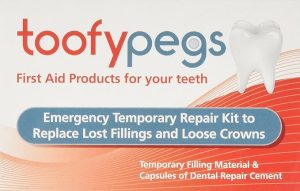What is a temporary crown? In short, temporary dental crowns are handy tooth-shaped caps that your dentist may give you while you wait until your permanent crown is ready to be cemented into place.
A few questions we will delve into in this article include:
- What makes it temporary?
- How long does a temporary crown last?
- What to do if my temporary crown falls off?
- How are temporary crowns made?
- Should you get one?
We’ll discuss all of these points and more, and get to the bottom of why you may need to top your teeth with a provisional crown.
What is a temporary crown?
We know from the intro and from its very name that a temporary crown is exactly that, temporary. But maybe we should back up a second and review what normal crowns are.
Normal crowns are a protective and aesthetic cover that can be used for both natural teeth and implants. Crowns are an excellent restorative solution to many problems, but they usually take two or three weeks to be made. So, while you’re waiting for your permanent crown, your dentist will likely recommend a temporary tooth cap that you can wear in the meantime.
Crowns are used to restore and enhance damaged teeth, or they can take the place of missing teeth. A crown, also known as a tooth cap, is used to entirely cover a damaged tooth. It not only strengthens the tooth but, drastically improves the appearance, shape and alignment.
Temporary tooth caps are a good option to help a patient before a permanent crown can be made and secured into place. It’s important to note that temporary crowns are more sensitive to breaking, so being extra careful when brushing, flossing, and eating is important.
Dr. Ashley Niles, Niles Family Dentistry
What are temporary tooth caps made of?
A temporary crown is made by your dentist right in their office, usually from an acrylic-based material or metal. An acrylic crown will match the colour of your teeth better than a steel one, although, it won’t be anywhere near as good of a match as the one being prepared for you in the lab. But, as it’s only temporary, its main function is to protect your implant or natural tooth until your real cap is made.
Get a free quote for dental treatment abroadTemporary crown vs permanent crown
What’s the difference between a temporary crown and a permanent crown? Besides the obvious, the differences between these two types of crowns are:
- Materials: Temporary crowns are made from metal or plastic, and permanent crowns are made from higher-quality materials such as gold, ceramic, or porcelain.
- Duration of wear: You will wear your provisional crown for two to three weeks, whereas your permanent crown can last anywhere from five to twenty-five years, depending on the quality.
- Form: Provisional crowns are made from a universal, one-size-fits-all form, that probably won’t perfectly match the shape of the opposite tooth, whereas your permanent crown will be a perfect fit for you.
- Fitting: Temporary crowns are cemented using temporary cement to your implant or tooth. Permanent crowns are fitted with permanent cement and they also might require additional adjustments, like tooth filing.
Have a look at the table below to see a summary of the differences between temporary crowns vs permanent crowns:
Temporary | Permanent | |
Materials | Acrylic (plastic) or metal | Gold, ceramic, stainless steel, or porcelain |
How long it lasts | 2–3 weeks | 5–25 years |
Form | Universal fit | Custom made to fit your mouth |
Fitting | Temporary cement | May need tooth filing or other adjustments before cementing with permanent cement |
Do temporary dental crowns hurt?
Some people experience tooth pain after temporary crown placement. Sometimes they are too tall and collide with the opposing tooth, and this can cause inflammation in your crowned tooth.
Pain can also occur when your temporary tooth cap isn’t properly sealed, and your dentin and nerves will be exposed to air, causing them to be sensitive to hot and cold temperatures. If you experience throbbing pain after temporary crown placement, there’s also the possibility that there could be underlying conditions like decay or infection that need to be addressed.
For minor discomfort or pain, you can try some home remedies for relief. But, if the pain becomes severe, or you experience prolonged temporary crown pain after a week, it’s time to call your dentist.
How to care for your temporary crown
Temporary crowns aren’t meant to last very long, but, for your own comfort and oral health, it’s important to take good care of it. So, let’s take a look at some of the important things to keep in mind while wearing a provisional cap.
Rules for eating and chewing

- Stay away from hard or sticky foods: You should be able to chew normally with your temporary dental crown. However, it’s best to avoid chewing on particularly hard or sticky foods like gum, hard candy, nuts, caramel, and apples. That’s right, an apple a day won’t keep the dentist away if you’ve got a temporary tooth cap!
- Just say no…to sugar: You should always avoid too many sugary foods for your oral and overall health, but, it’s even more important with temporary crowns. That’s because there may be a gap between the temporary cap and your gums, where sugar can get in and lead to decay.
- Don’t go to extremes: Stay away from extremely hot or extremely cold foods, as temporary cement for crowns may lose its staying power.
Hygiene
Keep your crown looking good, the tooth below and surrounding and gums healthy, and your adjacent teeth happy with proper oral hygiene. We advise that you:
- Brush your teeth at least twice a day (just like you would normally).
- Brush your crown gently.
- Take care not to dislodge the temporary crown cement while flossing.
It is important to note that string floss can easily catch on the edge of the crown, so a water flosser may be a better option. It can also be gentler on sore gums.
Get a free quote for dental treatment abroadWhat to do if your temporary crown falls off
Sometimes, temporary crowns fall off, and if that happens, the best thing you can do is call the dentist. They’ll want to replace it with another crown to ensure you don’t leave an empty space in your mouth, which can cause all sorts of problems.
If you aren’t able to see a dentist right away, you may want to consider a home tooth repair kit.
Toofypegs Emergency Temporary Repair Kit
Toofypegs is a good option for an emergency temporary repair kit, for both crowns and fillings. Like its name suggests it is a temporary fix until you can see a dentist. This repair kit includes 2 capsules of cement, so there is enough for two separate applications.

Repair Kit includes:
- 1 x Filling Stick
- 2 x Capsules of Dental Cement (Zinc Polycarboxylate)
- 4 x Mouthwash Tablets (mint flavoured)
Using it is simple, just add a drop of water to one of the capsules and mix well before applying.
The following video provides useful instructions on how you can replace your crown using Toofypegs Emergency Temporary repair Kit.
Conclusion
Temporary crowns are a way of protecting your gums, implant, or, natural tooth while you are waiting for a permanent cap to be made. They are normally made from a plastic acrylic material or metal, and they should be worn from two to three weeks unless your dentist specifies otherwise.
Some extra care needs to be taken with your temporary crown—you should avoid hard, sticky or chewy foods, very hot or cold foods, and sugary foods. You should also make sure to continue brushing at least twice a day, and flossing, but be a bit more careful around the tooth cap.
If you experiencing throbbing pain, call your dentist ASAP, however, a bit of discomfort is probably nothing to worry about. After all, it’s temporary, and soon you’ll have your new permanent tooth!
And remember, you can chat with a dentist at any time — 24/7 about your temporary crowns. A team of certified dentists is standing by at JustAnswer.
FAQs
How long does the pain last after temporary crown placement?
You may experience mild pain or discomfort while you wear your temporary crown. This is normal in most cases, and not likely to go away until you get your permanent one installed. If the pain doesn’t subside with painkillers or gets worse, call your dentist. If you are experiencing extreme pain, call your dentist ASAP.
What do I do if my temporary crown keeps falling off?
If your temporary crown fell off, you should go to your dentist and get it put back correctly. If it falls off another time, you should still contact your dentist. They’ll likely want to try to resolve the problem so it doesn’t continue. You can use temporary repair kits in the meantime, but it’s always best to talk to your dentist. Also, make sure to stay away from sticky and hard foods, as this can cause your temporary tooth cap to fall out.
What does a temporary crown feel like?
A temporary crown may be a bit uncomfortable since it’s not made to fit perfectly in your mouth. You might also notice that it doesn’t fit perfectly with the opposing tooth when your mouth is closed. Let your dentist know about any discomfort you are feeling, especially if that discomfort turns into throbbing pain.
NCBI: Knowledge of Consequences of Missing Teeth in Patients Attending Prosthetic Clinic in u.C.h. Ibadan. Consulted 23rd May 2020.





